[Note: This story was written on the day the product was announced for release in the Japanese market, and
was compiled based on information on Sony's Japanese website.
Sony has since announced the NR70 and NR70V for release in the US. Please watch for a review to be posted on this site soon.]
First seen in a brief glimpse at PalmSource 2002, Sony today announced their new NR series of Palm
OS based PDAs. Revolutionary with their tall clamshell design, their half-VGA (320 x 480, 65,536 color) color screens
are likely to turn plenty of heads. When first opened, a keyboard is revealed on the lower piece
of the clamshell, and just above that are the four standard Palm OS buttons and two scroll buttons.
But that's not the end of the interface. When open, the screen can pivot to face the other way, and when
closed it functions as a traditional Graffiti device, covering the keyboard.
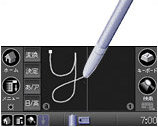
The next twist is that there is no static Graffiti area, instead it uses a virtual Graffiti area
that can move out of the way or turn into a keyboard as needed. Graffiti strokes also appear as a white
line on the dark input area, allowing users to see their characters, just like on the HandEra 330 and
on Pocket PCs.
There are two models that will be selling in Japan, the PEG-NR70 (49,000 Yen, or approx US$389;
available in Japan March 23)
and the PEG NR70V (59,800 Yen, or approx US$467; available in Japan April 13). [Sony USA's announced prices will
be US$499 for the NR70 and US$599 for the NR70V.] Both feature audio playback, and the NR70V features
a digital camera that captures still shots in resolutions of 320 x 240, 160 x 120, and 88 x 88. The camera can
rotate 300 degrees and its lens is f2.8 with a focal length equivalent to a 35mm lens on a 35mm film camera.

The display is their new backlit TFT LCD, first seen in the T615C. Also big news is that this will be
the first device to use Motorola's new Dragonball Super VZ 66MHz chip.
As with other units, audio can be played back from ATRAC-3 or MP3 format, and playback
features MegaBass for enhanced bass. Users can enjoy music through the included headphones or
via the built-in speakers on the back of the unit. Though the website
uses the word "recording" often, it is unclear whether either device has a microphone or mic jack.
[Note: The unit indeed does not have
recording capability. 5/1/2002]
Maximum Sound Recording Time is listed seperately from playback time, so it's a good possibility:
120 minutes at 132Kbps, 160 minutes at 105Kbps, 240 minutes at 66Kbps, all in ATRAC-3 format; and
65 minutes at 256Kbps, 130 minutes at 128Kbps, and 170 minutes at 96Kbps in MP3 format.
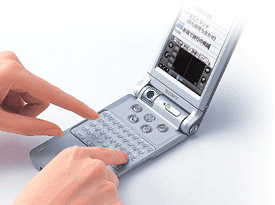
With this much power, it's almost a surprise that it only comes with 16MB RAM and 10MB Flash (the
US version would likely come with less Flash, since the Japanese OS usually takes more room). Of course
programs and data can also be stored on Memory Stick.
Dimensions are 2.84 x 5.37 x 0.65 inches, and weight is 7.05 ounces. The body is constructed
of Magnesium. The Jog Dial included in all previous CLIEs is also present on the NR series.
Battery life when playing audio
is around seven hours with the display off, and two with it on.
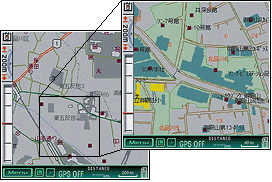
We haven't seen the units except on the Japanese website, but there is one interesting omission
evident: When you convert the device to a "Palm-like" device by rotating the screen, you no longer
have access to the hardware scroll buttons or hardware application buttons. Certainly you can use
scroll bar and basic icons, as well as the Jog Dial; Sony is also free to reprogram what appears to be an abnormally large Graffiti
area as they see fit. Another interesting oddity is the large area left completely function free
beneath the keyboard. A good place for small Post-its or perhaps a picture of a sweetheart? It will
be interesting to see.
The new devices come with a huge complement of software, including Documents to Go, CLIE Paint,
Remote Commander, and a map application that works with their GPS module called "Navin' You Pocket."
There's also CLIE Mail with the ability to send images captured on the NR70V via email as well.
It's a shame that Sony Japan and Sony USA can't coordinate these announcements, because
Sony USA's products come as no surprise to US customers. They are always announced first by Sony Japan,
and we're left wondering whether we'll be deemed worthy to receive the product. In their defense,
most US products are launched here first as well, so it's understandable. It does take some time to
ready product for another language, and with competition the way it is, they have to get their product
out there quickly.
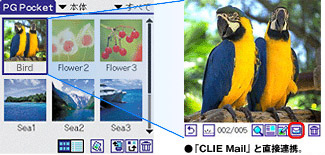
To my recollection, the only Palm OS device announced by Sony Japan that didn't make it here in some form
just a few
months later was the PEG-S500, a color model launched at the same time as the S300. Having seen that color
screen, I can tell you we didn't miss anything, since it was fuzzy and of low contrast. The
N-series color units that came later were far better and more worthy of four to five bills.
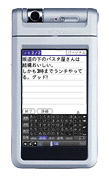
Given the specs of this unique device, Sony is poised to take on not only every Palm OS device out
there, but also Pocket PC in its many iterations. The potential inherent in vertical half-VGA resolution
is huge (current Pocket PCs offer quarter-VGA, or 240 x 320), and when you add the Bluetooth Memory Stick announced at the same time
(available in Japan March 23),
this Sony offers more than any currently announced PDA:
a superior combination of higher resolution, audio, digital imaging, and complete phone-based
wireless and sled-less connectivity.
[Author's note: The above paragraph has caused some confusion, so I'll clarify. When a Bluetooth
Memory Stick module comes out for the CLIE line, users will be able to wirelessly connect to a Bluetooth-enabled cell phone. Bluetooth is a
low-power wireless communications standard operating in the 2.4 GHz range, as does 802.11b or "Wi-Fi." In the next few months (hopefully)
US customers will be able to buy such cell phones from their network providers. Users will be able to combine several Bluetooth-enabled devices to
create what is being called a "Personal Area Network" (PAN). In such a setup, one can just tap the number listed in their PDA and the Bluetooth connection
will tell their cell phone to dial it. Likewise, a user can browse the Internet by using the cell phone as a connection to their ISP, all without
wires. Sony currently has no plans to release a cell phone module or Memory Stick with an integrated cell phone, as many have interpreted the above paragraph
to suggest. A Bluetooth module,
as seen with the Palm SD Bluetooth module, and Bluetooth cell phone would make such a module unnecessary. The above-described PAN is currently possible
with the Palm SD Bluetooth module and a Bluetooth-enabled cell phone, though these phones are as of this date only available in Europe.
The Sony Memory Stick Bluetooth module will likely be released
in the US this Fall, though no solid plans have been made yet, according to Sony representatives. -sab 5/1/2002]
-Shawn Barnett
Photos from Sony Japan website:
www.sony.co.jp/sd/products/Consumer/PEG/PEG-NR70V/
Questions? Comments?
Back to Palm Section

